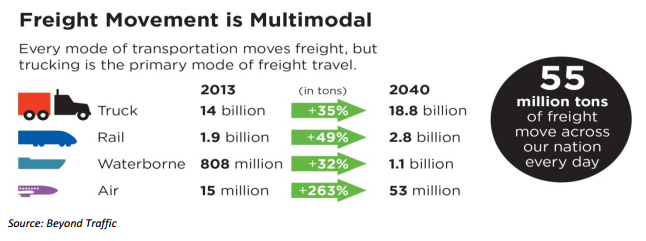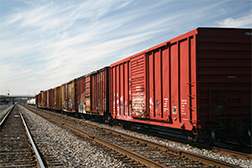A National Plan for the Future of Freight
Americans: We like our "stuff." Whether it’s clothing, books, or consumer electronics, we like our stuff to be readily available, such as at a fully stocked store. We like our stuff even more when it is where we want it to be, when we want it to be there.
Goods move from point A to point B, safely and on schedule, through a vast network of almost seven million miles of roads, rails, waterways, and pipelines linked by thousands of airports, seaports, and other freight-handling facilities.
This complex network directly supports 44 million jobs and underpins our quality of life. It makes possible the remarkable economy of America: On average, 63 tons of goods are moved for each one of us every year.
Significant effort goes into making this system work. But there are major challenges ahead.
Keeping Up with the Joneses—All of Them
By 2045, America’s population is forecast to grow by more than 20 percent. Our freight transportation system will need to keep pace with this growth and with changing trade and demand patterns. Maintaining an agile system is one of the key goals of the National Freight Strategic Plan (NFSP), now in draft form for public comment.
“One of the major points of the NFSP is that, as a nation, we need to figure out ways to better fund the freight transportation system, to more effectively invest in our freight infrastructure, and to keep pace with the national and global economy,” said Alisa Fine, a community planner at Volpe and a key member of the NFSP support team. “We need our freight infrastructure to be at an A-plus level.”
The NFSP was born from the most recent surface transportation law, MAP-21. Among other goals, the NFSP aims to increase the economic competitiveness, efficiency, and productivity of America’s freight network. It draws upon recommendations made in 2014 by the National Freight Advisory Committee, which was also created by MAP-21.
New Hurdles Ahead, New Opportunities to Move Forward
The challenges to maintaining our freight transportation system are sobering. Years of underinvestment in infrastructure means that, for instance, one-quarter of our public bridges are structurally deficient or obsolete.
The freight network is governed by a decentralized system of players from the public and private sectors, which allows for flexibility in reacting to local needs but can make it difficult to fund and plan freight projects.
These are existential barriers, and the NFSP is a major step forward in spotlighting the key challenges, and in ensuring that our freight transportation system can continue to adapt to a changing world. After all, as Volpe Deputy Director for Research and Technology Anne Aylward has said, “When you go to the store, you expect to find Cheerios on the shelf. How do you think the Cheerios got there? There’s no such thing as the immaculate conception of Cheerios. Freight has to move.”
“Freight transportation can seem invisible,” Fine said. “We expect the grocery store shelves to be stocked, but we don’t think about how the stuff gets there. This plan hopefully makes freight transportation more transparent to the public, and also offers strategies to make freight transportation safer, more efficient, and more reliable. Without an effective freight transportation system, we don’t have stuff—and we rely on that stuff for our quality of life."

